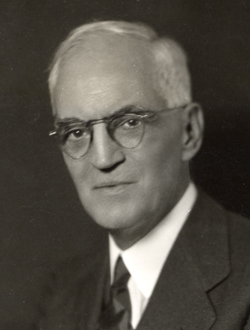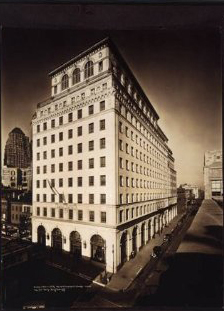John C. Parker

 Enlarge
Enlarge
John Castlereagh Parker (1879-1939) was recruited to the position from industry in 1915. He brought with him extensive experience in electric power transmission, gained from over 10 years of work with major infrastructure projects, and led the department through some major changes in curriculum and philosophy.
Born in Detroit, MI, Parker received his bachelor’s degree in mechanical engineering in 1901, a master’s degree in mathematics, physics, and engineering in 1902, and degree in electrical engineering in 1904 for work done in absentia.
Parker was hired as a tester for General Electric in 1902, and within two years was appointed assistant to the engineer in charge of the Niagara Construction Company. Their major ongoing project was the design and construction of a hydraulic plant with the Ontario Power Company on the Canadian side of Niagara Falls. In 1905 he became assistant to the vice-president and chief engineer of the Iroquois Construction Co., and soon after that the head of engineering staff at the Rochester Railway and Light Company.
In 1915, Parker was hired as Chair of the department. He had been giving Saturday morning lectures at Michigan on electric power transmission since 1910. He continued research on power transmission and pursued new work on the economic theory of engineering.
Under Parker, big changes took place in the curriculum and philosophy of the department. It was clear that electrical engineering was “growing up.” In the early days it was possible to get a full picture of the EE field within four years, right down to practical applications. The theory of EE advanced rapidly, though, and books and articles in the field were getting more and more mathematical.

 Enlarge
Enlarge
At the same time the scope of the applications of electricity grew. Radio became important, and electronics as a science was developing. It was no longer possible to cover the entire field as had been done in the past in four years.
In response to these changes, the department decided to cut down on overly-specific courses and strengthen the department’s foundational courses. Electrical companies were in favor of these changes. The number of courses in the late 1910’s actually went down briefly as this restructuring place.
Parker returned to industry in 1922 to work for Brooklyn Edison Company, where he became Vice President. He is credited with overseeing the comprehensive reconstruction of the company’s transmission and distribution system, which involved novel work in the development of a low voltage network type of distribution service.
In 1938, Parker served as president of the American Institute of Electrical Engineers, an organization that would eventually become IEEE. He also directed and led a number of electrical companies and professional organizations in New York throughout the ‘20s and ’30, including time as Director of the New York and Queens Electric Light and Power Co., Director of the American Standards Association, and Director and Treasurer of Electrical Testing Laboratories.
References and Further Reading

 MENU
MENU 
